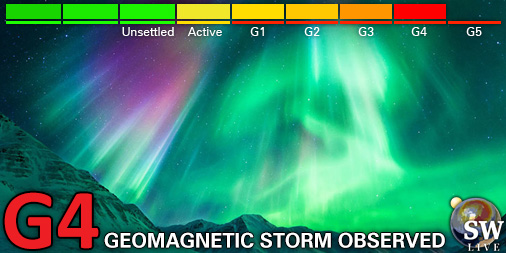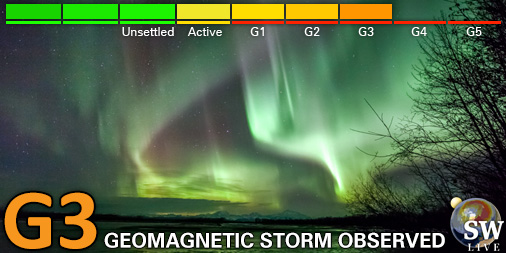Viewing archive of Friday, 10 November 2000
Solar activity report
Any mentioned solar flare in this report has a scaling factor applied by the Space Weather Prediction Center (SWPC). Because of the SWPC scaling factor, solar flares are reported as 42% smaller than for the science quality data. The scaling factor has been removed from our archived solar flare data to reflect the true physical units.
Report of Solar-Geophysical Activity 2000 Nov 10 2200 UTCPrepared by the NOAA © SWPC and processed by SpaceWeatherLive.com
Joint USAF/NOAA Report of Solar and Geophysical Activity
SDF Number 315 Issued at 2200Z on 10 Nov 2000IA. Analysis of Solar Active Regions and Activity from 09-2100Z to 10-2100Z
Solar activity was low. Today's largest event was a
C6/1f from Region 9225 (S20W48) at 09/2122Z. There appears to be
some gradual flux emergence in this region. The rest of today's
activity consisted of a few low-level C-class events. Two new
regions were assigned today, Region 9229 (N04E70) and Region 9230
(N05W39). Both are simple and stable. There has been a noticeable
decline in activity and in background levels as regions 9218, 9212,
and 9213 rotate around the west limb.
IB. Solar Activity Forecast
Solar activity is expected to be low
to moderate. Regions 9218 (N21W83) and 9227 (S13E24) appear to be
the most likely sources for activity at this time.
IIA. Geophysical Activity Summary 09-2100Z to 10-2100Z
The geomagnetic field has been at unsettled to major storm levels.
The field was initially running at unsettled to active levels, but a
strong interplanetary shock passed the ACE spacecraft at 0604Z and
was followed promptly by a sudden impulse at 0629Z (measuring 67 nT
in Boulder), and a period of minor to major storm level activity
(i.e. K-indices of 5 and 6). The solar wind following the shock did
not exhibit strongly southward fields, and the result was a weaker
disturbance than had been expected, with a decline to active to
unsettled during the last nine hours of the period. This shock most
likely is the result of the CME associated with the M7 flare of 8
November, and the solar wind signatures are consistent with an
interpretation that the Earth received a glancing, rather than a
direct blow from the interplanetary disturbance. Event level proton
fluxes continued today at the greater than 10 MeV and 100 MeV
levels. Flux levels declined throughout the period, with current
levels (as of 10/2100Z) of 192 pfu and 1.3 pfu at 10 MeV and 100 MeV
respectively.
IIB. Geophysical Activity Forecast
The geomagnetic field is
expected to be mostly active during the next 24 hours, but there may
be with periods of minor to major storm levels, particularly during
local nighttime hours. Active levels are expected to continue
through the second day and partway through the third day, as effects
are expected from a favorably positioned coronal hole. The greater
than 100 MeV proton event should end within a few hours, but the
greater than 10 MeV event is likely to continue into the third day.
III. Event Probabilities 11 Nov to 13 Nov
| Class M | 35% | 35% | 35% |
| Class X | 05% | 05% | 05% |
| Proton | 99% | 99% | 70% |
| PCAF | in progress | ||
IV. Penticton 10.7 cm Flux
Observed 10 Nov 153 Predicted 11 Nov-13 Nov 150/150/150 90 Day Mean 10 Nov 173
V. Geomagnetic A Indices
Observed Afr/Ap 09 Nov 010/011 Estimated Afr/Ap 10 Nov 030/040 Predicted Afr/Ap 11 Nov-13 Nov 025/035-020/020-015/020
VI. Geomagnetic Activity Probabilities 11 Nov to 13 Nov
| A. Middle Latitudes | |||
|---|---|---|---|
| Active | 40% | 40% | 30% |
| Minor storm | 30% | 30% | 20% |
| Major-severe storm | 10% | 10% | 10% |
| B. High Latitudes | |||
|---|---|---|---|
| Active | 15% | 15% | 25% |
| Minor storm | 50% | 50% | 40% |
| Major-severe storm | 20% | 20% | 15% |
All times in UTC
Latest news
Latest forum messages
2025/04/12-13 Filament CMEs 2025/04/16 G3 Watch 458Power Grid Reclosers 1AR4062 36Incoming & Unnumbered Active Regions 1741AR4064 8
More topicsSupport SpaceWeatherLive.com!
A lot of people come to SpaceWeatherLive to follow the Sun's activity or if there is aurora to be seen, but with more traffic comes higher server costs. Consider a donation if you enjoy SpaceWeatherLive so we can keep the website online!

Latest alerts
Wednesday, 16 April 2025
21:45 UTC - Geomagnetic activity
Minor G1 geomagnetic storm (Kp5) Threshold Reached: 21:36 UTC
21:00 UTC - Geomagnetic activity
Severe G4 geomagnetic storm (Kp8) Threshold Reached: 20:55 UTC
19:45 UTC - Geomagnetic activity
Strong G3 geomagnetic storm (Kp7) Threshold Reached: 19:25 UTC
19:00 UTC - Geomagnetic activity
Moderate G2 geomagnetic storm (Kp6) Threshold Reached: 18:38 UTC
18:45 UTC - Geomagnetic activity
Minor G1 geomagnetic storm (Kp5) Threshold Reached: 18:28 UTC
Space weather facts
| Last X-flare | 2025/03/28 | X1.1 |
| Last M-flare | 2025/04/15 | M1.2 |
| Last geomagnetic storm | 2025/04/15 | Kp6+ (G2) |
| Spotless days | |
|---|---|
| Last spotless day | 2022/06/08 |
| Monthly mean Sunspot Number | |
|---|---|
| March 2025 | 134.2 -20.4 |
| April 2025 | 124.1 -10.1 |
| Last 30 days | 122.5 -17.8 |







